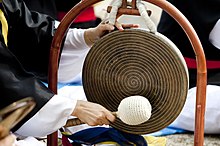216:. The jing is one of four percussion instruments that provide exquisite and fine rhythms in a planned and systematic manner in accordance with the culture of traditional Korean folk rhythms. Another cultural aspect of the Saml nori music tradition includes a variety of the dancing movements in diverse forms of performers. The jing's history is very much associated with this beautiful and diverse form of traditional Korean percussion.
400:
343:
29:
150:, and military music for ceremonies and special occasions, varying in size for each occasion. It is capable of producing a gentle and lingering sound as well as a big sound with a roaring effect, depending on force applied when striking against the brass. Although the
258:
142:
to keep beat. It is usually made from high-quality brass and is struck by a stick that is layered with cloth at one end to soften the texture of the sound produced. It is typically played in farmer,
441:
434:
384:
475:
460:
427:
233:
288:
75:
293:
377:
154:
is a percussion instrument, it has a constant pitch and produces a harmonious and beautiful sound on its own.
204:
210:). The jing is most widely used in a newer form of a traditional Korean genre of percussion music called
89:
470:
370:
411:
354:
237:
111:
465:
454:
399:
283:
212:
126:
407:
138:
342:
313:
147:
132:
207:
80:
65:
143:
41:
350:
57:
121:
28:
94:
415:
358:
88:
74:
56:
40:
35:
124:used in traditional Korean music, particularly in
435:
378:
8:
198:
172:
162:
115:
63:
47:
442:
428:
385:
371:
193:The jing's name was originally pronounced
27:
225:
18:
7:
396:
394:
339:
337:
414:. You can help Knowledge (XXG) by
357:. You can help Knowledge (XXG) by
16:Korean traditional gong instrument
14:
398:
341:
289:Encyclopedia of Korean Culture
173:
163:
116:
64:
48:
1:
95:
81:
492:
476:Idiophone instrument stubs
461:Korean musical instruments
393:
336:
177:) according to the pitch.
406:This article relating to
294:Academy of Korean Studies
234:"Traditional Instruments"
199:
26:
21:
157:Jing is classified into
353:-related article is a
263:www.culturecontent.com
203:, deriving from the
181:is low-pitched, and
76:Revised Romanization
318:www.koreamusic.org
423:
422:
366:
365:
189:Cultural presence
185:is high-pitched.
102:
101:
90:McCune–Reischauer
483:
444:
437:
430:
402:
395:
387:
380:
373:
345:
338:
328:
327:
325:
324:
310:
304:
303:
301:
300:
279:
273:
272:
270:
269:
255:
249:
248:
246:
245:
236:. Archived from
230:
202:
201:
176:
175:
166:
165:
119:
118:
98:
84:
69:
68:
51:
50:
31:
19:
491:
490:
486:
485:
484:
482:
481:
480:
451:
450:
449:
448:
392:
391:
334:
332:
331:
322:
320:
312:
311:
307:
298:
296:
281:
280:
276:
267:
265:
257:
256:
252:
243:
241:
232:
231:
227:
222:
191:
70:
52:
17:
12:
11:
5:
489:
487:
479:
478:
473:
468:
463:
453:
452:
447:
446:
439:
432:
424:
421:
420:
403:
390:
389:
382:
375:
367:
364:
363:
346:
330:
329:
305:
274:
250:
224:
223:
221:
218:
190:
187:
100:
99:
92:
86:
85:
78:
72:
71:
62:
60:
54:
53:
46:
44:
38:
37:
33:
32:
24:
23:
15:
13:
10:
9:
6:
4:
3:
2:
488:
477:
474:
472:
469:
467:
464:
462:
459:
458:
456:
445:
440:
438:
433:
431:
426:
425:
419:
417:
413:
409:
404:
401:
397:
388:
383:
381:
376:
374:
369:
368:
362:
360:
356:
352:
347:
344:
340:
335:
319:
315:
309:
306:
295:
291:
290:
285:
278:
275:
264:
260:
259:"징 - 문화콘텐츠닷컴"
254:
251:
240:on 2013-01-13
239:
235:
229:
226:
219:
217:
215:
214:
209:
206:
196:
188:
186:
184:
180:
170:
160:
155:
153:
149:
145:
141:
140:
135:
134:
129:
128:
123:
120:) is a large
113:
109:
108:
97:
93:
91:
87:
83:
79:
77:
73:
67:
61:
59:
55:
45:
43:
39:
34:
30:
25:
20:
416:expanding it
405:
359:expanding it
348:
333:
321:. Retrieved
317:
308:
297:. Retrieved
287:
277:
266:. Retrieved
262:
253:
242:. Retrieved
238:the original
228:
211:
194:
192:
182:
178:
168:
158:
156:
151:
137:
131:
125:
106:
105:
103:
471:Korea stubs
205:Sino-Korean
114::
36:Korean name
455:Categories
408:idiophones
323:2024-01-30
314:"한국전통소리문화"
299:2021-05-04
268:2021-06-02
244:2014-09-19
220:References
213:samul nori
127:samul nori
139:daechwita
148:Buddhist
284:"징 (鉦)"
282:이, 숙희.
133:pungmul
183:Sujing
179:Amjing
169:Sujing
167:) and
159:Amjing
144:shaman
136:, and
112:Korean
42:Hangul
466:Gongs
410:is a
351:Korea
349:This
195:jeong
96:ching
58:Hanja
412:stub
355:stub
152:jing
122:gong
107:jing
104:The
82:jing
22:Jing
457::
316:.
292:.
286:.
261:.
174:수징
164:암징
146:,
130:,
443:e
436:t
429:v
418:.
386:e
379:t
372:v
361:.
326:.
302:.
271:.
247:.
208:鉦
200:정
197:(
171:(
161:(
117:징
110:(
66:鉦
49:징
Text is available under the Creative Commons Attribution-ShareAlike License. Additional terms may apply.
